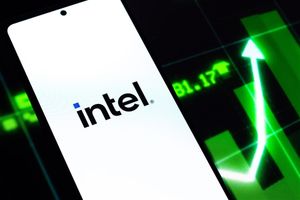
The year 2025 has unfolded as a testament to the stock market's perplexing resilience, with major indices shrugging off a barrage of global headwinds to achieve remarkable gains. Despite persistent geopolitical tensions festering across Europe and the Middle East, the imposition of sweeping new tariffs, and even a temporary government shutdown, the market has not only held its ground but surged to new record highs, leaving many analysts scratching their heads at its "defy-gravity" performance. This unapologetically bullish sentiment, emerging particularly after a mid-year downturn, suggests a powerful underlying momentum that continues to propel equities forward, challenging conventional economic logic.
This unusual market behavior has created a landscape of both bewilderment and opportunity. As of mid-October 2025, the S&P 500 (INDEXSP:.INX) has climbed approximately 13% year-to-date, potentially marking a third consecutive year of double-digit gains—a rare feat in market history. This sustained upward trajectory, especially in the face of significant external pressures, highlights a collective investor instinct to embrace risk and a renewed focus on long-term growth narratives, even as extreme valuations become more commonplace across various market segments.
Navigating the Tempest: A Year of Shocks and Surges
The year began with roaring optimism, largely fueled by accelerating investments in Artificial Intelligence (AI). However, this exuberance was dramatically interrupted in April 2025 by a significant market downturn, triggered by United States President Donald Trump's announcement of new, sweeping tariff policies, dubbed "Liberation Day." These tariffs, impacting nearly all sectors of the US economy and escalating trade wars with China, Canada, and Mexico, sent shockwaves across global markets, leading to a widespread stock market crash and panic selling. Goldman Sachs (NYSE: GS) had previously estimated that a 5-percentage-point increase in the US tariff rate could reduce S&P 500 earnings per share by 1-2%, and the initial reaction validated these concerns.
However, the market's innate ability to adapt and rebound quickly became evident. Following the Trump administration's announcement of a pause in tariff increases in early April, a significant stock market rally ensued, demonstrating the market's sensitivity to trade policy shifts and its capacity for rapid recovery once tariff-related anxieties subsided. This remarkable rebound saw the S&P 500 (INDEXSP:.INX) surge over 20% from its mid-April lows, regaining its momentum and reigniting the bull market. Further challenges emerged with a US government shutdown between September 20th and October 1st, 2025, which cast a shadow over economic data and added uncertainty. Yet, the market largely shrugged off the data vacuum, continuing its upward march. Key players throughout this period include the Federal Reserve, whose anticipated interest rate cuts have provided a tailwind, and technology and semiconductor companies, which have been at the forefront of the AI investment boom. Investors themselves have played a crucial role, exhibiting an "unapologetically bullish" sentiment that has driven risk-on strategies.
Corporate Fortunes: Who Wins and Who Loses in a Defying Market
In a market that defies gravity, certain sectors and companies are positioned to thrive, while others may struggle to keep pace or even face significant headwinds. The primary beneficiaries of 2025's unusual rally have been companies deeply entrenched in the Artificial Intelligence (AI) ecosystem.
Winners:
- Technology Giants (NASDAQ: AAPL, NASDAQ: MSFT, NASDAQ: GOOGL, NASDAQ: AMZN, NASDAQ: NVDA): Companies at the forefront of AI development and infrastructure, particularly those involved in cloud computing, software, and advanced chip manufacturing, have seen substantial gains. Nvidia (NASDAQ: NVDA), a leading designer of graphics processing units (GPUs) essential for AI, has been a standout performer, benefiting immensely from accelerating AI investments. Microsoft (NASDAQ: MSFT), with its extensive cloud services and AI integrations, and Alphabet (NASDAQ: GOOGL), with its AI research and applications, have also capitalized on this trend.
- Semiconductor Companies: Beyond the immediate tech giants, the broader semiconductor industry has experienced a boom. Companies producing the foundational hardware for AI computing power are witnessing surging demand, driving their stock prices upward.
- Companies with Robust Earnings Growth: The market's strength is underpinned by strong corporate earnings. Companies across various sectors that have consistently met or exceeded earnings expectations, often driven by efficiency gains or market share expansion, have been rewarded by investors. Anticipated double-digit corporate earnings growth (12-13%) for 2025-2026, fueled by AI and a stable interest rate environment, bodes well for these firms.
- Companies with Strong Balance Sheets: In an environment of lingering inflation and potential interest rate shifts, companies with healthy balance sheets and low debt levels are more resilient and attractive to investors.
Potential Losers/Underperformers:
- Companies Highly Sensitive to Tariffs: While the market initially rebounded from the April tariff shock, companies heavily reliant on global supply chains or export markets, particularly those with significant exposure to China, Canada, or Mexico, may still face margin pressures or reduced demand if tariff policies become more aggressive or unpredictable in the future. Industries like manufacturing, automotive, and certain consumer goods could be vulnerable.
- Companies with Weak Fundamentals: The "defy-gravity" market might mask underlying weaknesses in companies with poor earnings, high debt, or outdated business models. While speculative "froth pockets" exist (quantum-computing, alternative-power, AI-supply-chain, crypto-treasury), a sustained rationalization could expose these vulnerabilities.
- Small-Cap and Value Stocks (potentially): While the market as a whole is up, the rally has largely been led by a few mega-cap technology stocks. Smaller companies or traditional "value" sectors might struggle to keep pace with the outsized gains of the growth-oriented tech leaders, leading to a widening market breadth issue.
- Companies with High Input Costs: Lingering inflation, even as the Fed eases policy, could erode the profitability of companies facing rising costs for raw materials, labor, or energy, especially if they lack pricing power.
The market's current structure suggests that innovation, particularly in AI, and strong financial health are key determinants of corporate success in this unusual economic climate.
Broader Implications: A New Era of Market Dynamics?
The stock market's unusual performance in 2025, characterized by its ability to defy economic gravity and logic, carries significant wider implications, suggesting a potential shift in market dynamics and investor psychology. This event fits into a broader industry trend where technological innovation, particularly in Artificial Intelligence, has become an overwhelmingly dominant factor, often overshadowing traditional economic indicators and geopolitical risks. The market's rapid rebound from the April tariff shock underscores its newfound resilience and perhaps a desensitization to what would historically be considered major destabilizing events.
The ripple effects are profound. Competitors in industries not directly involved in AI are being pressured to integrate AI into their operations or risk being left behind. This creates a powerful incentive for cross-sector innovation and collaboration. Partners in supply chains for technology and semiconductor companies are experiencing unprecedented demand, while those tied to more traditional or tariff-sensitive industries face increased volatility. Regulatory bodies are also grappling with the implications of such a market. The rapid ascent of AI-driven companies raises questions about market concentration, potential monopolies, and the need for new frameworks to govern AI development and its economic impact. The Federal Reserve's anticipated rate cuts further complicate the picture, as easier monetary policy typically fuels asset bubbles, potentially exacerbating the "froth pockets" identified in speculative market segments.
Historically, periods where markets decouple from fundamental economic realities or geopolitical tensions often precede significant corrections. The Dot-Com bubble of the late 1990s, where valuations soared on speculative tech plays, serves as a cautionary tale. Similarly, the "Nifty Fifty" era in the 1960s and early 70s saw a small group of large-cap growth stocks dominate, only to face a severe downturn. However, a key difference in 2025 is the tangible and transformative impact of AI on corporate earnings and productivity, which provides a more fundamental underpinning than pure speculation. The market's ability to absorb shocks like a government shutdown and trade wars also points to a robust underlying demand for equities, possibly driven by the sheer volume of capital seeking returns in a low-yield environment and the potential for money market funds to flow into stocks as rates decline. This blend of speculative excitement and genuine technological advancement creates a unique and complex historical precedent.
The Road Ahead: Navigating an Uncharted Landscape
Looking ahead, the stock market's trajectory in the short-term will likely remain highly sensitive to a few critical factors. Continued progress and investment in Artificial Intelligence will be paramount; any slowdown or significant regulatory hurdles in AI development could dampen investor enthusiasm. The Federal Reserve's monetary policy decisions, specifically the timing and magnitude of anticipated interest rate cuts, will also play a crucial role in maintaining liquidity and supporting valuations. Geopolitical developments, while seemingly shrugged off thus far, could still trigger market volatility if tensions escalate dramatically or lead to unforeseen economic consequences.
In the long-term, the market faces both immense opportunities and significant challenges. Strategic pivots or adaptations will be required from companies across all sectors. Those that successfully integrate AI into their business models, enhance productivity, and innovate will likely continue to outperform. Conversely, companies that fail to adapt to this technological shift or are overly exposed to persistent trade disputes could face sustained pressure. Market opportunities may emerge in areas adjacent to AI, such as cybersecurity, data management, and specialized hardware. There could also be opportunities in sectors that leverage AI to revolutionize traditional industries, like healthcare, finance, and logistics.
Potential scenarios and outcomes are varied. A "soft landing" scenario, where inflation continues to moderate, the Fed executes well-timed rate cuts, and AI-driven productivity gains fuel corporate earnings, could see the market continue its upward trajectory, albeit with increased volatility. Another scenario involves a "hard landing," where geopolitical tensions escalate, tariffs become more disruptive, or AI hype outpaces real-world applications, potentially leading to a significant market correction. A third, more nuanced outcome, could see a bifurcation of the market, where AI-driven tech giants continue to thrive, while other sectors struggle, leading to a less broad-based rally. Investors should prepare for a dynamic environment where adaptability and a keen eye on both technological advancements and macroeconomic shifts will be crucial.
Wrapping Up: A Market Redefining Resilience
The year 2025 will undoubtedly be remembered as a pivotal period for the stock market, defined by its extraordinary ability to defy gravity and logic in the face of considerable adversity. The key takeaway from this unprecedented performance is the powerful influence of Artificial Intelligence as a market driver, capable of overshadowing persistent geopolitical tensions, new tariffs, and even a government shutdown. This resilience, underpinned by robust corporate earnings and the anticipation of supportive monetary policy from the Federal Reserve, suggests a market that has developed a higher tolerance for risk and a strong focus on long-term growth narratives.
Moving forward, the market's trajectory will hinge on the sustained momentum of AI innovation, the careful calibration of interest rate policies, and the containment of geopolitical risks. While the current bullish sentiment is strong, the presence of "froth pockets" in speculative segments and the high valuations across the board warrant caution. Investors should be prepared for potential shifts in market leadership and increased volatility as the market navigates this complex landscape.
What investors should watch for in the coming months includes the quarterly earnings reports of major technology and semiconductor companies for signs of sustained AI-driven growth, any new announcements or pauses regarding tariff policies, and the Federal Reserve's communications on interest rates. Furthermore, monitoring the broader economic data for signs of a softening labor market or renewed inflationary pressures will be critical. The 2025 market has demonstrated a remarkable capacity for resilience, but understanding the underlying drivers and potential risks will be essential for navigating what promises to be an equally dynamic period ahead.
This content is intended for informational purposes only and is not financial advice


















